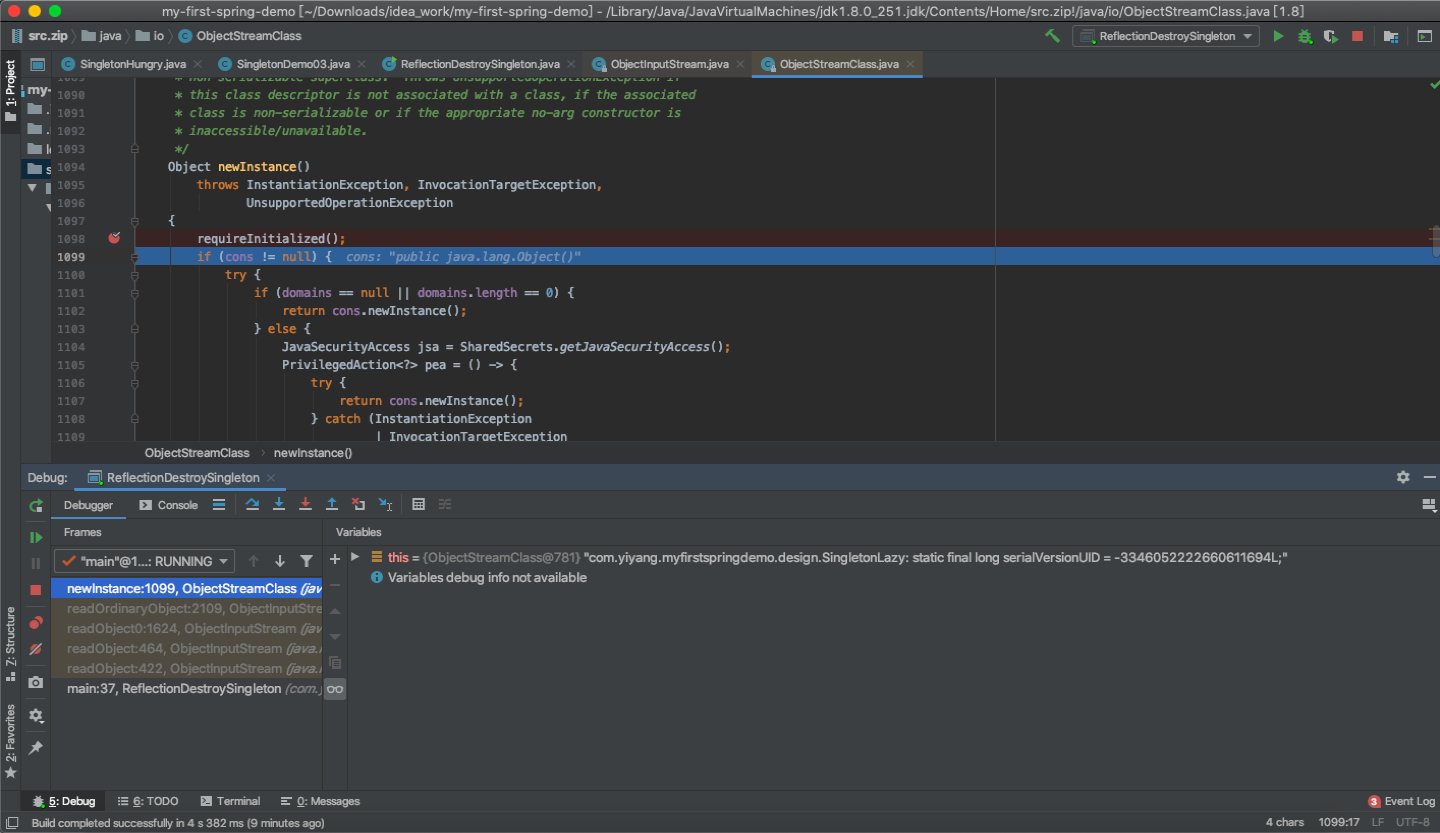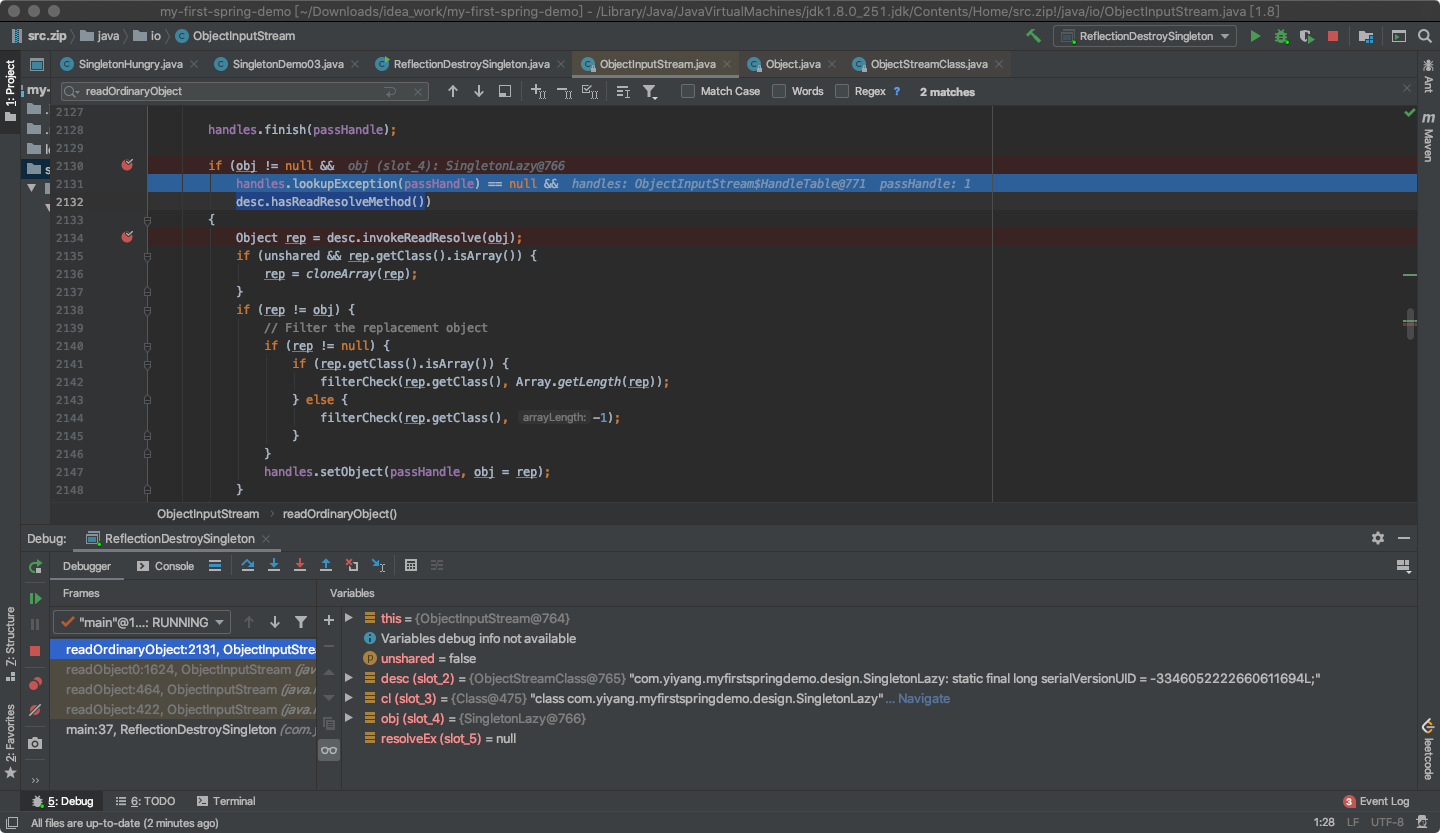java设计模式—单例模式(包含单例的破坏)
什么是单例模式?
保证一个了类仅有一个实例,并提供一个访问它的全局访问点。
单例模式的应用场景?
- 网站的计数器,一般也是采用单例模式实现,否则难以同步;
- Web应用的配置对象的读取,一般也应用单例模式,这个是由于配置文件是共享的资源;
- 数据库连接池的设计一般也是采用单例模式,因为数据库连接是一种数据库资源;
- 多线程的线程池的设计一般也是采用单例模式,这是由于线程池要方便对池中的线程进行控制。
单例的优缺点?
优点:
- 提供了对唯一实例的受控访问;
- 由于在系统内存中只存在一个对象,因此可以 节约系统资源,当 需要频繁创建和销毁的对象时单例模式无疑可以提高系统的性能;
- 避免对共享资源的多重占用
缺点:
- 不适用于变化的对象,如果同一类型的对象总是要在不同的用例场景发生变化,单例就会引起数据的错误,不能保存彼此的状态;
- 由于单利模式中没有抽象层,因此单例类的扩展有很大的困难;
- 单例类的职责过重,在一定程度上违背了“单一职责原则”。
单例的创建方式
饿汉式
类初始化时,会立即加载该对象,线程安全,效率高。
/*** @Author 刘翊扬* @Version 1.0*/public class SingletonHungry {private static SingletonHungry instance = new SingletonHungry();private SingletonHungry() {}public static SingletonHungry getInstance() {return instance;}}
验证:
public class Main {public static void main(String[] args) {SingletonHungry instance1 = SingletonHungry.getInstance();SingletonHungry instance2 = SingletonHungry.getInstance();System.out.println(instance1 == instance2); // 结果是true}}
优点:仅实例化一次,线程是安全的。获取实例的速度快
缺点:类加载的时候立即实例化对象,可能实例化的对象不会被使用,造成内存的浪费。
使用静态代码块
/*** @author 刘翊扬*/public class HungrySingleton2 {private static HungrySingleton2 instance = null;private HungrySingleton2() {}static {instance = new HungrySingleton2();}private HungrySingleton2() {}public static HungrySingleton2 getInstance() {return instance;}}
懒汉式
public class SingletonLazy {private static SingletonLazy instance;private SingletonLazy() {}public static SingletonLazy getInstance() {if (instance == null) {instance = new SingletonLazy();}return instance;}}
优点:在使用的时候,创建对象,节省系统资源
缺点:
- 如果获取实例时,初始化的工作量较多,加载速度会变慢,影响系统系能
- 每次获取对象,都要进行非空检查,系统开销大
- 非线程安全,当有多个线程同时调用 getInstance()方法,时,会有线程安全问题,可能导致创建多个对象
静态内部类
/*** @Author 刘翊扬* @Version 1.0*/public class SingletonDemo03 {private SingletonDemo03() {}public static class SingletonClassInstance {private static final SingletonDemo03 instance = new SingletonDemo03();}public static SingletonDemo03 getInstance() {return SingletonClassInstance.instance;}}
优势:兼顾了懒汉模式的内存优化(使用时才初始化)以及饿汉模式的安全性(不会被反射入侵)。
劣势:需要两个类去做到这一点,虽然不会创建静态内部类的对象,但是其 Class 对象还是会被创建,而且是属于永久带的对象。
使用枚举
枚举本身就是单例的,一般在项目中定义常量。
例如:
/*** @Author 刘翊扬* @Version 1.0*/public enum ResultCode {SUCCESS(200, "SUCCESS"),ERROR(500, "ERROR");private Integer code;private String msg;ResultCode(Integer code, String msg) {this.code = code;this.msg = msg;}public Integer getCode() {return code;}public void setCode(Integer code) {this.code = code;}public String getMsg() {return msg;}public void setMsg(String msg) {this.msg = msg;}}
/*** @Author 刘翊扬* @Version 1.0*/public class User {private User() {}public static User getInstance() {return SingletonDemo04.INSTANCE.getInstance();}private static enum SingletonDemo04 {INSTANCE;// 枚举元素为单例private User user;SingletonDemo04() {user = new User();}public User getInstance() {return user;}}}
解决线程安全问题
使用双重检测锁
public class LazySingletonDemo1 {private static LazySingletonDemo1 instance = null;public static LazySingletonDemo1 getInstance() {if (instance == null) {synchronized (LazySingletonDemo1.class) {if (instance == null) {instance = new LazySingletonDemo1();}}}return instance;}}
这里使用双重检测,是为了防止,当实例存在的时候,不在走同步锁,减少使用锁带来的性能的消耗。
单例模式一定能保证只有一个实例对象吗?
答案是:不能
破坏单例的两种方式:
- 反射
- 反序列化
反射破坏
通过反射是可以破坏单例的,例如使用内部类实现的单例。通过反射获取其默认的构造函数,然后使默认构造函数可访问,就可以创建新的对象了。
/*** @Author 刘翊扬* @Version 1.0*/public class ReflectionDestroySingleton {public static void main(String[] args) throws IllegalAccessException, InstantiationException, NoSuchMethodException, InvocationTargetException {SingletonLazy instance = SingletonLazy.getInstance();Class aClass = SingletonLazy.class;// 获取默认的构造方法Constructor<SingletonLazy> declaredConstructor = aClass.getDeclaredConstructor();// 使默认构造方法可访问declaredConstructor.setAccessible(true);// 创建对象SingletonLazy instance2 = declaredConstructor.newInstance();System.out.println(instance == instance2); // 结果是:false}}
怎么阻止???
可以增加一个标志位,用来判断构造函数是否被调用了。
public class SingletonLazy {// 标志位private static Boolean isNew = false;private static SingletonLazy instance;private SingletonLazy() {synchronized (SingletonLazy.class) {if (!isNew) {isNew = true;} else {throw new RuntimeException("单例模式被破坏!");}}}public static SingletonLazy getInstance() {if (instance == null) {instance = new SingletonLazy();}return instance;}}
再次运行:

注意:
增加标志位的确能阻止单例的破坏,但是这个代码有一个BUG,那就是如果单例是先用的反射创建的,那如果你再用正常的方法getInstance()获取单例,就会报错。因为此时标志位已经标志构造函数被调用过了。这种写法除非你能保证getInstance先于反射执行。
public static void main(String[] args) throws IllegalAccessException, InstantiationException, NoSuchMethodException, InvocationTargetException {Class aClass = SingletonLazy.class;// 获取默认的构造方法Constructor<SingletonLazy> declaredConstructor = aClass.getDeclaredConstructor();// 使默认构造方法可访问declaredConstructor.setAccessible(true);// 创建对象SingletonLazy instance2 = declaredConstructor.newInstance();System.out.println("反射实例:" + instance2);// 再次调用SingletonLazy instance = SingletonLazy.getInstance();System.out.println(instance == instance2); // 结果是:false}
结果:

反序列化
SingletonLazy要实现Serializable接口
public static void main(String[] args) throws Exception {//序列化SingletonLazy instance1 = SingletonLazy.getInstance();ObjectOutputStream out = new ObjectOutputStream(new FileOutputStream("tempfile.txt"));out.writeObject(SingletonLazy.getInstance());File file = new File("tempfile.txt");ObjectInputStream in = new ObjectInputStream(new FileInputStream(file));//调用readObject()反序列化SingletonLazy instance2 = (SingletonLazy) in.readObject();System.out.println(instance1 == instance2); // 结果是:false}
原理解释:
反序列化为什么能生成新的实例,必须从源码看起。这里分析readObject()里面的调用源码。会发现readObject()方法后进入了readObject0(false)方法。
public final Object readObject()throws IOException, ClassNotFoundException{if (enableOverride) {return readObjectOverride();}// if nested read, passHandle contains handle of enclosing objectint outerHandle = passHandle;try {Object obj = readObject0(false); //通过debug会发现进入此方法handles.markDependency(outerHandle, passHandle);ClassNotFoundException ex = handles.lookupException(passHandle);if (ex != null) {throw ex;}if (depth == 0) {vlist.doCallbacks();}return obj;} finally {passHandle = outerHandle;if (closed && depth == 0) {clear();}}}
分析readObject0方法,通过debug进入了readOrdinaryObject()方法。
private Object readObject0(Class<?> type, boolean unshared) throws IOException {boolean oldMode = bin.getBlockDataMode();if (oldMode) {int remain = bin.currentBlockRemaining();if (remain > 0) {throw new OptionalDataException(remain);} else if (defaultDataEnd) {/** Fix for 4360508: stream is currently at the end of a field* value block written via default serialization; since there* is no terminating TC_ENDBLOCKDATA tag, simulate* end-of-custom-data behavior explicitly.*/throw new OptionalDataException(true);}bin.setBlockDataMode(false);}byte tc;while ((tc = bin.peekByte()) == TC_RESET) {bin.readByte();handleReset();}depth++;totalObjectRefs++;try {switch (tc) {.... 省略部分源码case TC_OBJECT:if (type == String.class) {throw new ClassCastException("Cannot cast an object to java.lang.String");}return checkResolve(readOrdinaryObject(unshared)); // 通过debug发现进入到了readOrdinaryObject()方法。.... 省略部分源码}} finally {depth--;bin.setBlockDataMode(oldMode);}}
通过分析,readOrdinaryObject()中有两处关键代码,其中关键代码1中的关键语句为:
此处代码是通过描述对象desc,先判断类是否可以实例化,如果可以实例化,则执行desc.newInstance()通过反射实例化类,否则返回null。
obj = desc.isInstantiable() ? desc.newInstance() : null;
private Object readOrdinaryObject(boolean unshared)throws IOException{if (bin.readByte() != TC_OBJECT) {throw new InternalError();}ObjectStreamClass desc = readClassDesc(false);desc.checkDeserialize();Class<?> cl = desc.forClass();if (cl == String.class || cl == Class.class|| cl == ObjectStreamClass.class) {throw new InvalidClassException("invalid class descriptor");}Object obj;try {// 关键代码=========obj = desc.isInstantiable() ? desc.newInstance() : null;} catch (Exception ex) {throw (IOException) new InvalidClassException(desc.forClass().getName(),"unable to create instance").initCause(ex);}passHandle = handles.assign(unshared ? unsharedMarker : obj);ClassNotFoundException resolveEx = desc.getResolveException();if (resolveEx != null) {handles.markException(passHandle, resolveEx);}if (desc.isExternalizable()) {readExternalData((Externalizable) obj, desc);} else {readSerialData(obj, desc);}handles.finish(passHandle);if (obj != null &&handles.lookupException(passHandle) == null &&desc.hasReadResolveMethod()){Object rep = desc.invokeReadResolve(obj);if (unshared && rep.getClass().isArray()) {rep = cloneArray(rep);}if (rep != obj) {// Filter the replacement objectif (rep != null) {if (rep.getClass().isArray()) {filterCheck(rep.getClass(), Array.getLength(rep));} else {filterCheck(rep.getClass(), -1);}}handles.setObject(passHandle, obj = rep);}}return obj;}
通过断点调试,发现其调用了desc.newInstance()方法。

我们知道调用newInstance()方法,一定会走类的无参构造方法,但是上面通过debug我们发现,cons的类型是Object类型,所以,这里面应该是调用类Object的无参构造方法,而不是SingletonLazy类的无参构造
那么怎么改造呢????
继续debug调试:查看readOrdinaryObject()方法

发现,desc.hasReadResolveMethod()这个方法返回的false,所以导致没有执行if条件下面的语句。
desc.hasReadResolveMethod() // 从方法名可以看到,这个方法的名字是检查desc这个(SingleLazy)对象有没有readResolve()方法。
我们现在阻止破坏单例,应该只需要在SingleLazy类中,实现自己的readResolve()方法即可。
public Object readResolve() {return instance;}
现在我们在看看运行的结果:为true

大功告成。。。。
java设计模式—单例模式(包含单例的破坏)的更多相关文章
- Java设计模式:Singleton(单例)模式
概念定义 Singleton(单例)模式是指在程序运行期间, 某些类只实例化一次,创建一个全局唯一对象.因此,单例类只能有一个实例,且必须自己创建自己的这个唯一实例,并对外提供访问该实例的方式. 单例 ...
- 【java设计模式】之 单例(Singleton)模式
1. 单例模式的定义 单例模式(Singleton Pattern)是一个比較简单的模式.其原始定义例如以下:Ensure a class has only one instance, and pro ...
- Java面试 - 什么是单例设计模式,为什么要使用单例设计模式,如何实现单例设计模式(饿汉式和懒汉式)?
什么是单例设计模式? 单例设计模式就是一种控制实例化对象个数的设计模式. 为什么要使用单例设计模式? 使用单例设计模式可以节省内存空间,提高性能.因为很多情况下,有些类是不需要重复产生对象的. 如果重 ...
- Java设计模式 - - 单例模式 装饰者模式
Java设计模式 单例模式 装饰者模式 作者 : Stanley 罗昊 [转载请注明出处和署名,谢谢!] 静态代理模式:https://www.cnblogs.com/StanleyBlogs/p/1 ...
- Java设计模式-单例模式(Singleton)
单例对象(Singleton)是一种常用的设计模式.在Java应用中,单例对象能保证在一个JVM中,该对象只有一个实例存在.这样的模式有几个好处: 1.某些类创建比较频繁,对于一些大型的对象,这是一笔 ...
- Java设计模式の单例模式
-------------------------------------------------- 目录 1.定义 2.常见的集中单例实现 a.饿汉式,线程安全 但效率比较低 b.单例模式的实现:饱 ...
- java设计模式 - 单例模式(干货)
深度讲解23种设计模式,力争每种设计模式都刨析到底.废话不多说,开始第一种设计模式 - 单例. 作者已知的单例模式有8种写法,而每一种写法,都有自身的优缺点. 1,使用频率最高的写法,废话不多说,直接 ...
- java设计模式单例模式 ----懒汉式与饿汉式的区别
常用的五种单例模式实现方式 ——主要: 1.饿汉式(线程安全,调用率高,但是,不能延迟加载.) 2.懒汉式(线程安全,调用效率不高,可以延时加载.) ——其他: 1.双重检测锁式(由于JVM底层内部模 ...
- JAVA设计模式-单例模式(Singleton)线程安全与效率
一,前言 单例模式详细大家都已经非常熟悉了,在文章单例模式的八种写法比较中,对单例模式的概念以及使用场景都做了很不错的说明.请在阅读本文之前,阅读一下这篇文章,因为本文就是按照这篇文章中的八种单例模式 ...
随机推荐
- HashSet 和 HashMap 的比较
HashMap 和 HashSet 都是 collection 框架的一部分,它们让我们能够使用对象的集合.collection 框架有自己的接口和实现,主要分为 Set 接口,List 接口和 Qu ...
- JMeter Gui – TestElement约定[转]
转自https://www.cnblogs.com/yigui/p/7615635.html 在编写任何JMeter组件时,必须注意某些特定的约定--如果JMeter环境中正确地运行JMeter组件, ...
- Lazysysadmin靶机
仅供个人娱乐 靶机信息 Lazysysadmin靶机百度云下载链接:https://pan.baidu.com/s/1pTg38wf3oWQlKNUaT-s7qQ提取码:q6zo 信息收集 nmap全 ...
- 破解网站码验证,Java实现,不调用任何平台api接口
package image.images; import java.io.File; import java.io.IOException; import java.io.InputStream; i ...
- OpenGL学习笔记(五)变换
目录 变换 向量 向量的运算 向量与标量运算 向量取反 向量加减 求向量长度 向量的单位化 向量相乘 点乘(Dot Product) 叉乘 矩阵 矩阵的加减 矩阵的数乘 矩阵相乘 矩阵与向量相乘 与单 ...
- C 购买商品的游戏
1 #include <stdio.h> 2 #include <stdlib.h> 3 #include <string.h> 4 /* 5 *模拟实现道具店购物 ...
- 05.表达式目录树Expression
参考文章 https://www.cnblogs.com/xyh9039/p/12748983.html 1. 基本了解 1.1 Lambda表达式 演变过程 using System; namesp ...
- 玩转Java8日期工具类-基础
内容基于的是 Java8官方文档,以及Java时间类总结 的总结.BTW:其实具体方法的使用直接在IDEA中看源码更方便直接. 1.老一辈:Java.util.Date Java.sql.Date J ...
- Python语言系列-02-基础数据类型
格式化输出 #!/usr/bin/env python3 # author:Alnk(李成果) # 百分号% 格式化输出 name = input('姓名:') age = input('年龄:') ...
- Let's Encrypt泛域名使用和Nginx配置拆分
上一期写了 使用Let's Encrypt实现网站https化 ,随着二级域名的增多,每个二级域名需要一张 SSL 证书,这可太不优雅了,泛域名表示我可以更优雅. 作者:IT王小二 博客:https: ...
